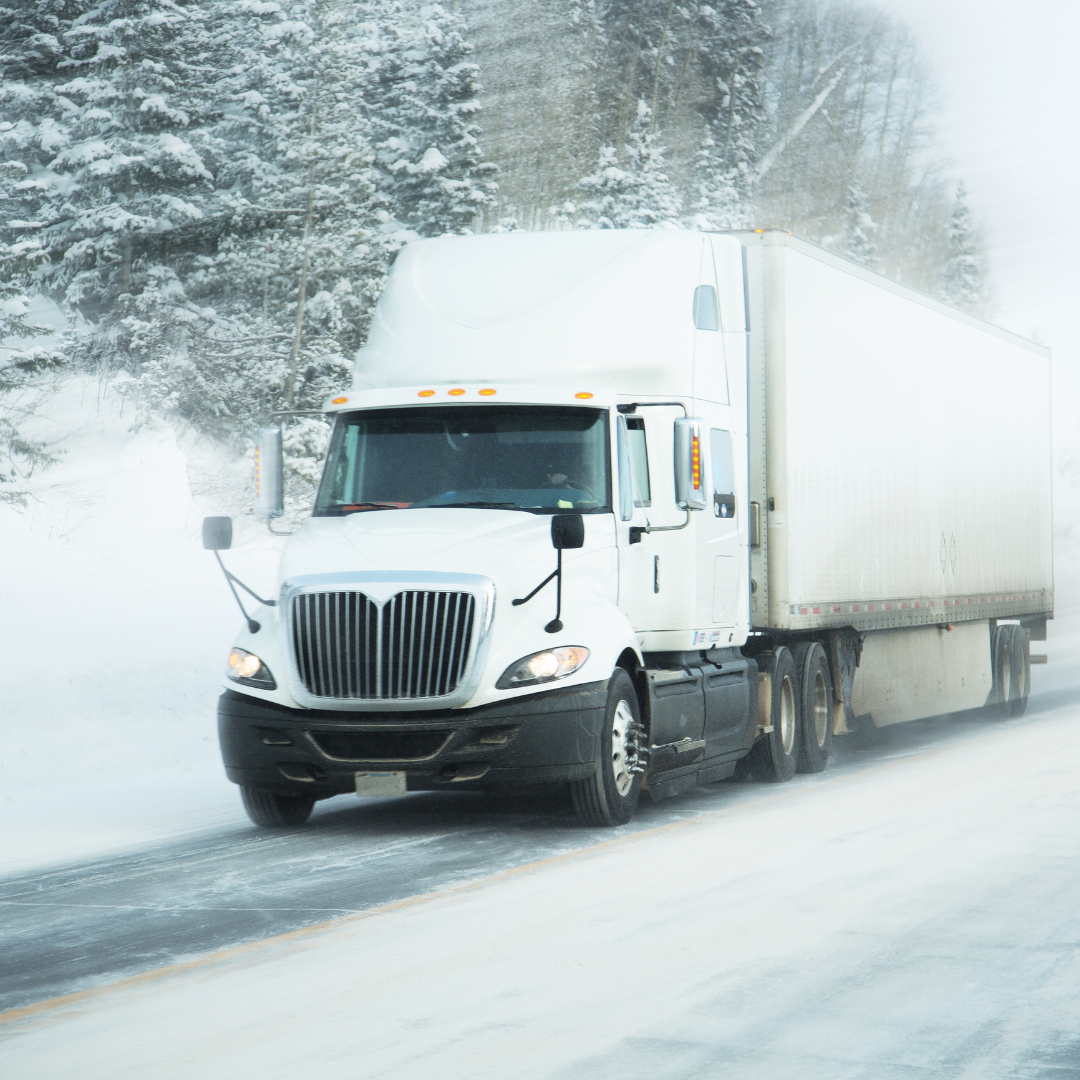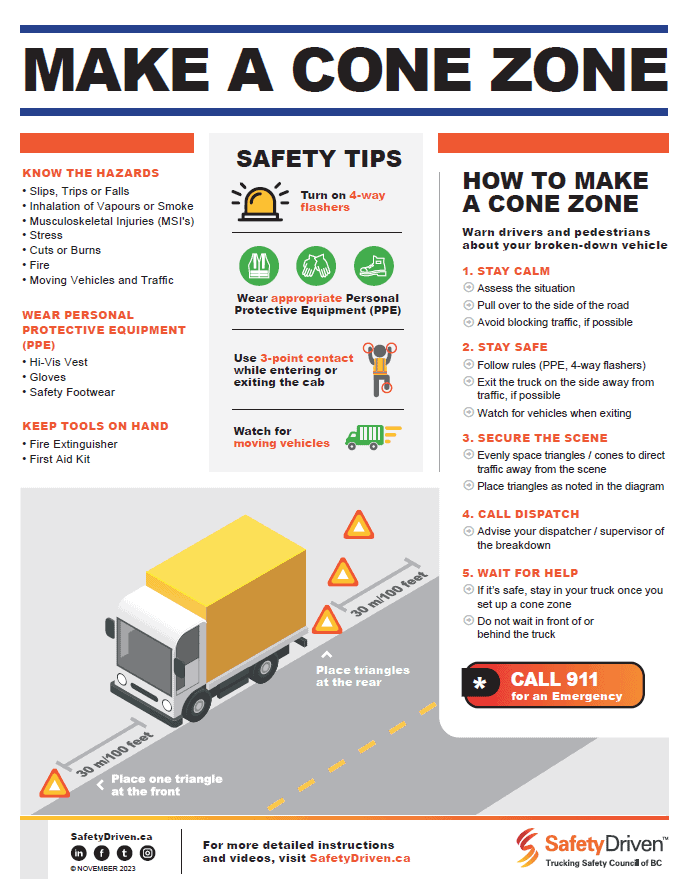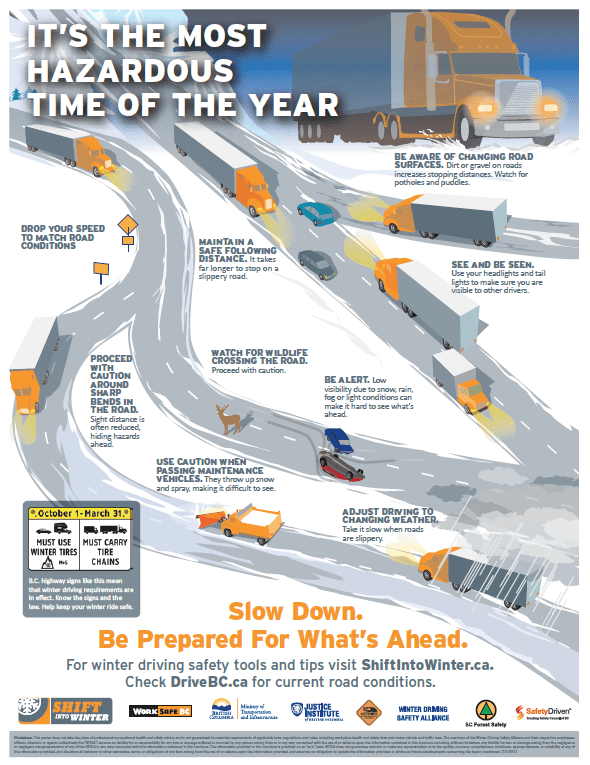
How to Safely Descend Mountain Grades
Driving through B.C. may offer up scenic views and mountain vistas, but it also poses challenges to drivers that most other provinces in Western Canada lack.
With its steep grades, twists and turns, and perilous mountainside drop-offs, drivers must navigate some the most treacherous terrain, and brake management is essential.
As Andy Roberts, president of Mountain Transport Institute, a driver training school in Castlegar, B.C., explains, drivers of all types of vehicles need to shed the habit of using their service brakes to slow down while descending a hill.
“They shouldn’t even be using their brakes,” Roberts said of truck drivers traveling down mountain grades. “Your brakes are designed to stop you, or to slow you down for a downshift. Brakes were never designed in any vehicle – big trucks, cars, pickup trucks – to hold you back while going down a hill.”
Roberts said when it comes to incidents where a truck’s brakes seize up, or even catch fire – as was reported to have happened several times this summer in the Kamloops, B.C. area – it is usually a case of the driver descending a steep grade too fast and being forced to apply their brakes.
“They need to slow down at the top of the hill and select the gear that’s going to allow them to descend the grade using their auxiliary braking systems,” said Roberts, “like their engine brakes or their retarders, or whatever their vehicle is equipped with.”
Roberts said service brakes need to be kept cool in the event a driver comes across an emergency situation, like an accident, a rock slide, or even engine brake failure, so they can apply the brakes to bring the truck to abrupt stop.
Peter Faminoff, owner of Columbia Driver Training Centre in Port Coquitlam, B.C., said many drivers who are inexperienced with B.C.’s terrain must resist the urge to rely on their service brakes.
How drivers manage and use their brakes has to be ingrained early on in a driver’s career, which is why training schools play a significant role.
“When they teach the air brake course, 99% of the teachers only teach paper knowledge and no practical knowledge,” claimed Faminoff, adding that instructors need to inform new drivers how to properly descend steep grades. “I teach that if your brakes are properly adjusted, you use the proper gear, your engine as a retarder, and very little brakes, you’ll never get into trouble. But 99% of the students that I talk to, they look at you with this dumb look on their face.”
6 psi: The magic number
Faminoff said he teaches his students that if they’re going up a hill in in fourth gear, they should be in second or third gear going back down.
“Then you only use about a six-psi brake application,” he said. “At a six-psi brake application the system will take care of itself, it will dissipate the heat. If you analyze everything in perspective, you stay out of trouble, but if you don’t understand that and nobody teaches it to you, you get in trouble.”
Dave Earle, president and CEO of the B.C. Trucking Association agreed that slowing down a heavy truck is all about gear selection and speed.
“Drivers use the compression of the engine to manage the energy created as they move down a grade,” said Earle. “If the gear is too high, the engine will not be able to maximize compression resistance, increasing speed and meaning that other braking systems will have to be used to supplement. This supplementing is fine, as long as no system is overloaded. It’s all about managing dynamic energy.”
To make things more perplexing for drivers is that there are little to no warning signs that the brakes have become too hot. Faminoff said the most obvious indicator the truck’s brakes are seizing up is that the brake pedal no longer works. By then it’s too late.
“The warning sign is that you’re pressing harder (on the brakes) and you have no brakes,” he said. “It doesn’t matter how hard you press it, it does nothing.”
So, what does a driver do if they are in a situation where their brakes are gone?
“You’re dead,” cautioned Faminoff, saying he does not hold back when telling his students of the danger of not utilizing the braking system properly. Roberts added that along with an unresponsive brake pedal, a driver may see smoke coming off the wheels if their brakes have seized up.
“As the brakes heat up, the drums expand away from the shoes,” he said. “So, we either build enough heat to start a fire or the drums get hot enough and expand enough that the brakes literally don’t work anymore.”
Let the engine brake do its job
Roberts agreed with Faminoff that when drivers ascend a steep grade, they should descend in a similar or lower gear to contain the speed of the truck, as the engine brake will play a vital role holding back the momentum.
“It’s horsepower up the hill, it’s braking horsepower down the hill,” said Roberts. “The mistake that drivers make is that they are in too big a hurry.”
Using the drive from Calgary, Alta., to Vancouver, B.C., as an example, Roberts said drivers can be fooled by the size of the downhill grades, as these tend to increase the further west you go.
“There are a bunch of hills between (Calgary) and Vancouver, and a lot of the hills through the Roger’s Pass and places like that are shorter. So, drivers run off them at speed using their service brakes, and the hill is over before they build up too much heat,” Roberts explained. “But when you get in the area of the Coquihalla from Kamloops to Merritt, and Merritt down to Hope, the hills are a lot longer, so when they attempt to use the same technique – which is the wrong technique – before the hill ends, they overheat their brakes and get themselves into a heap of trouble.”
Take advantage of brake checks
Roberts said brake check areas serve a couple purposes, one being to get the driver stopped so they avoid having to brake over the top of the hill before coming down. It also gives drivers the opportunity to make sure their brakes are properly adjusted, something he feels a lot of drivers overlook.
“The quality of driver on the highway today, we don’t see the level of professionalism we have seen in years past,” Roberts said. “I run into a lot of drivers who just don’t take this quite as seriously as I would like them to. It’s a lot of weight, and it’s a lot of responsibility.”
Brad Zall, health and safety advisor for SafetyDriven, Trucking Safety Council of B.C., told Today’s Trucking that drivers should be checking that their air compressor has a full reservoir, there are no air leaks, gladhands and air lines are secure, push rod travel is within tolerance on all brake chambers, drums, bearings, brake lines, and tires are not hot or showing excessive wear, and that there are no broken components on the braking system.
B.C. has its share of high mountains summits on its network of highways, with the three highest elevations being Kootenay Pass from Salmo to Creston (1,774 meters), Pennask Summit 50 kms east of Merritt (1,728 meters), and Kicking Horse Pass in Yoho National Park (1,643 meters).
Stay up to date and sign up for one of our newsletters for more topics on Seasonal Driving, Commercial Vehicle Safety and more!
Latest Resources
Make a Cone Zone
Dowload this poster for tips on how to make a safe cone zone.Winter Hazards Poster
Drivers need to recognize winter hazards. Share this poster to remind drivers how to ...

